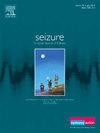Incidence and independently associated variables of acute postoperative seizures after epilepsy surgery
IF 2.7
3区 医学
Q2 CLINICAL NEUROLOGY
引用次数: 0
Abstract
Objective
This study aimed to investigate the incidence and independently associated variables of acute postoperative seizures (APOS) occurring in the first postoperative week after resective epilepsy surgery.
Methods
We retrospectively analyzed clinical data from consecutive patients who underwent resective epilepsy surgery in a tertiary hospital. The clinical characteristics of patients with and without APOS were compared, and binary logistic regression was used to identify the independently associated variables of APOS.
Results
Of the 1269 epilepsy surgeries (1261 patients) included in this analysis, 10.6 % (134/1269) resulted in APOS. Univariate analysis showed that sex, age at surgery, epilepsy duration, seizure frequency, number of anti-seizure medications (ASMs) at the time of surgery, drug resistant epilepsy (DRE); previous surgery, interictal EEG, intracranial monitoring, surgical extent, and complications were associated with APOS. When surgery was limited to a single brain lobe, frontal and parietal lobe surgery were more likely to result in APOS than temporal lobe surgery (11.7 %, 17.2 % vs. 7.5 %, p = 0.033, 0.008, respectively). Multivariate analysis demonstrated that an epilepsy duration of ≥3.75 years (OR 1.789 95 % CI 1.128–2.837 p = 0.013), using ≥3 types of ASMs at the time of surgery (OR 1.649 95 % CI 1.025–2.652 p = 0.039), and complications (OR 1.761 95 % CI 1.179–2.628 p = 0.006) were the independently associated variables of APOS. Postoperative seizure outcome at last follow-up was significantly worse in patients with APOS than in those without (Engel class Ⅰ: 41.1 % vs. 70.4 % p < 0.001).
Conclusions
The overall incidence of APOS in our cohort was moderate. Surgery for temporal lobe epilepsy was less likely to result in APOS. Early surgery, use of fewer ASMs, and control of complications were independently associated with a lower incidence of APOS.
癫痫手术后急性术后发作的发生率及独立相关变量
目的探讨切除性癫痫手术后第一周急性术后癫痫发作(APOS)的发生率及独立相关变量。方法回顾性分析某三级医院连续行切除性癫痫手术患者的临床资料。比较有APOS和无APOS患者的临床特征,并采用二元logistic回归确定APOS的独立相关变量。结果本组1269例癫痫手术(1261例)中,10.6%(134/1269)发生APOS。单因素分析显示:性别、手术年龄、癫痫持续时间、发作频率、手术时抗癫痫药物(asm)使用次数、耐药癫痫(DRE);既往手术、间期脑电图、颅内监测、手术范围和并发症与APOS相关。当手术仅限于单个脑叶时,额叶和顶叶手术比颞叶手术更容易导致APOS(11.7%, 17.2%比7.5%,p = 0.033, 0.008)。多因素分析显示,癫痫持续时间≥3.75年(OR 1.789 95% CI 1.128 ~ 2.837 p = 0.013)、手术时使用≥3种asm (OR 1.649 95% CI 1.025 ~ 2.652 p = 0.039)和并发症(OR 1.761 95% CI 1.179 ~ 2.628 p = 0.006)是APOS的独立相关变量。在最后一次随访中,APOS患者的术后癫痫发作结果明显差于无APOS患者(Engel分类Ⅰ:41.1% vs. 70.4% p <;0.001)。结论本研究队列中APOS的总体发生率为中等。颞叶癫痫的手术不太可能导致APOS。早期手术、使用更少的asm和并发症的控制与APOS发生率的降低独立相关。
本文章由计算机程序翻译,如有差异,请以英文原文为准。
求助全文
约1分钟内获得全文
求助全文
来源期刊

Seizure-European Journal of Epilepsy
医学-临床神经学
CiteScore
5.60
自引率
6.70%
发文量
231
审稿时长
34 days
期刊介绍:
Seizure - European Journal of Epilepsy is an international journal owned by Epilepsy Action (the largest member led epilepsy organisation in the UK). It provides a forum for papers on all topics related to epilepsy and seizure disorders.
 求助内容:
求助内容: 应助结果提醒方式:
应助结果提醒方式:


